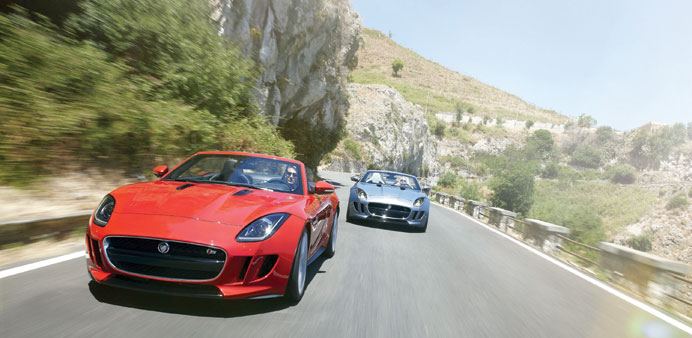The 2014 Jaguar F-Type is considered a sucessor to the brand’s iconic E-Type sports car.
By Larry Printz
Following in the footsteps of a famous parent is difficult; just ask Jakob Dylan, Rufus Wainwright or George W Bush. The 2014 Jaguar F-Type, which hit showrooms in June (in the US), faces the same challenge.
Its forebear, the 1961 Jaguar E-Type, was heralded as a work of art from its introduction. Created before the advent of government regulation, the E-Type was so unlike anything else that had come before or since, it quickly became iconic, a lifestyle prop to swinging London, the British Invasion and Carnaby Street.
So what do you do for an encore? How do you follow something that’s legendary from its inception? Such brilliance rarely happens twice.
Consider what the F-Type faces. It must meet government mandates across multiple continents. At the same time, it must satisfy the Jaguar loyalists who have been clamouring for this car since the E-Type staggered offstage in 1974, a victim of safety regulations, notorious British build quality, a V-12 engine with cooling problems, and an ill-advised redesign that left it looking like the automotive equivalent of Elvis Presley circa 1977 — bloated, but beloved.
Yes, the F-Type is a more rational creature than its parent. How could it be anything else? And yet the F-Type avoids the pitfalls of other automotive sequels. There’s no slavish adherence to arcane styling decisions made decades before. This is a modern sports car. More importantly, it’s a modern Jaguar sports car, with two seats, rear-wheel drive and it’s available in three flavours.
The base F-Type, base price $69,000 (in the US), is fitted with a 3.0-litre supercharged V-6 that develops 340hp and reaches 60mph in 5.1 seconds. If that’s not fast enough, you’ll be happy to learn that the higher-priced F-Types deliver more performance, not extra luxury.
So stepping up to F-Type S, priced at $81,000, nets another 40hp from the same engine and reduces 0-60mph time to 4.8 seconds. At the top of the food chain sits the F-Type S V-8, with a base price of $92,000. This is the feral cat of the family, with 495hp and 20-inch wheels, able to reach 60 mph in just 4.2 seconds.
Meow.
The F-Type S V-8 I drove was ridiculously fun, delivering abundant power with a delightfully raspy, ferocious exhaust snarl accentuated by backfiring pops loud enough to disturb the neighbours and make dogs bark. And you can make it louder by hitting the active exhaust button, which opens up the exhaust baffles. It’s part of the $2,950 performance package. If you opt for the V-8, you want this. Trust me.
The package also includes firm sculpted performance seats with adjustable side bolsters, a flat-bottomed steering wheel, red brake calipers and Configurable Dynamic Mode, which allows you to customise the response of the throttle, steering, suspension and transmission.
As the V-8’s power pours out, the tyres grab madly at the pavement, wailing their sweet melody as the back end twitches wildly, allowing just enough tail dancing to be mischievously fun. The scenery blurs as speed builds and the exhaust unleashes its unearthly howl. The eight-speed transmission snaps off the shifts so quickly you may not miss a manual transmission.
There’s no sensory deprivation in this car. The hydraulic-assisted power steering is perfectly tuned, nicely weighted and provides the right amount of feedback. Handling response is tight and quick; there’s no noticeable body roll in corners. Grip is tenacious; maintaining a line through corners is easy once you rotate the tail to where you want it.
The base F-Type’s firm ride tells you that it’s a performance car; yet it still has enough absorbency in the suspension to be comfortable, although it can still pogo over closely spaced bumps.
By contrast, the F-Type S, with its V-6 engine, doesn’t have the V-8’s deep well of torque. There’s plenty of power, but you must build the revs and speed first. Steering and handling are a bit more buttoned down, as is the exhaust note, which trades the V-8’s magnificently evil caterwaul for a classic European sports car sound.
It’s worth driving the V-6 before the V-8 to see which personality suits you. Regardless of model, the F-Type’s performance is remarkable; it’s a true sports car.
It’s a feeling reinforced by the interior, which is sporty and luxurious without feeling opulent. Designers decorated this cabin masterfully, keeping it simple and functional, while adding dramatic touches, such as the air vents, which rise out of the dash when the car starts.
The fully automatic roof folds in a mere 12 seconds. Once down, wind management is remarkably good. Airflow is not intrusive; it’s just enough to make driving delightful.
Put the roof up and you’ll find that the windows do not go up after the roof does, so you must raise them separately. However, the top is very well-insulated. So once it’s in place, you won’t hear any wind noise, although you will hear the exhaust note more clearly as well as road and tire noise.
Storage space is minimal; there’s no room behind the seats and the oddly shaped trunk holds just 7 cu ft.
Remember, this is a sports car. And it’s unique.
It doesn’t feel like an Audi, Porsche, BMW, Mercedes-Benz or, for that matter, an E-Type. That car might have influenced the F-Type, but they have their own personalities. — The Virginian-Pilot/MCT
* Price and technical specifications may vary in locally available models.

